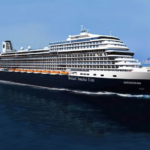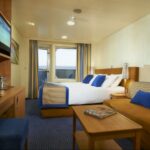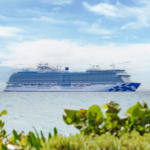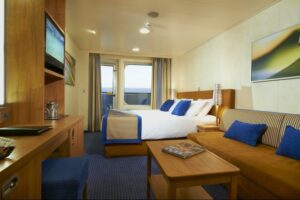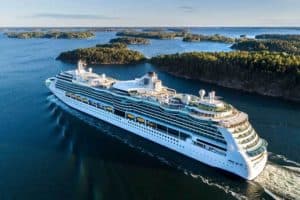Wondering how stable cruise ships can really be? If you’ll be on a cruise soon and you wonder if the possibility of it tipping over is high, read on ahead to be informed!
Can cruise ships tip over? While it’s not uncommon for cruise ships to tip to one side (no matter how far off to one side), they are designed in such a way that they won’t tip over. This design includes carefully planned weight distribution and stabilizers.
For many people, going on a cruise is a once-in-a-lifetime experience that they should definitely not miss. While most will think the ship is fail-safe, others may need to have some concerns addressed first. One of these concerns may be whether the cruise ship tip over.
Perhaps you’ve seen in a movie that a luxury liner tips over because a gigantic wave (or perhaps a humungous sea monster) knocked it out.
A cruise ship tipping to one side is something that happens fairly often. This is because of how it is affected by the movement of waves. Gentle to moderate waves will certainly make for some side-to-side swaying action.
Meanwhile, larger waves won’t cause the entire ship to completely tip over to the point that it cannot be righted up.
What Keeps a Boat from Tipping Over?
A cruise ship keeps itself from being completely tipped over to one side because it is designed to have a balance between buoyancy and weight. The topmost part of the ship maintains a ship’s buoyancy while the bottommost part weighs it down.
This buoyancy and weight are managed in the exact middle part of the ship to maintain its centering. If the ship is too buoyant, it will maintain a more upward position while in the water. However, if a cruise ship has too much weight, much of it will be pulled down closer underwater. The balance between the two is what we call floating.
Matters of Stability
A carefully planned outbalance between buoyancy and weight also results in a ship’s stability. The design of the ship itself determines this. If you look at most cruise ships, much of it can be found right below the water.
What pulls the ship down are the heavier parts of the ship that are needed for its operation – cargo, engines and machinery, living quarters for the crew, fuel, and all the other things that most cruise ship goers don’t really come in contact with.
These things are heavy, so they are placed at the bottom of the ship to maintain the center of gravity. The heavier objects being placed lower in the boat stabilize the entire ship’s buoyancy, keeping it grounded underwater.
Rooms and amenities that are considered lighter – such as theaters, restaurants, pools, dining rooms, etc. – are found on the ship’s upper levels. They are considered light because they aren’t densely packed like the things that maintain the center of gravity.
They are light because they contain a lot of room and space for air and movement of the passengers. The stability of the ship is maintained from one end to the other because the things that determine its center of gravity are spread throughout the ship’s entire width.
This great YouTube video addresses in detail the explanation to the question, “Can cruise ships tip over?” It clearly explains and illustrates this concept for you to understand how cruise ships maintain their stability.
Cruise Ships and Large Waves: A Lesson on Stability
Some people might worry that a huge wave – like those seen in movies – might cause a cruise ship to tip over or capsize. Many movies show this, but the good news is that it won’t! Those are all just cinematic effects and rarely happen in real life.
The most that a large wave can do is to create a wild and rough back and forth motion on the ship. If you are inside the cruise ship when this happens, you might panic. Visions of the movie ‘Titanic’ or ‘The Poseidon Adventure’ could come to mind.
However, in today’s times, it is unlikely for something like that to happen to a cruise ship that’s hit by a large wave. This is because of the ship’s stabilizers. In huge water transportation such as a cruise ship, you will want little wave movements to keep things on the upper decks as steady as possible.
This is achieved by stabilizers found at the lower half of a cruise ship. These stabilizers counteract the tipping force of the ship caused by the waves. They act like invisible hands that keep the cruise ship’s side from tipping over completely and instead gently pushing it back to the middle and upper side to maintain a gentler buoyancy.
The below explanation of how exactly stabilizers work to keep cruise ships upright is something useful to watch. The concept is explained in simple language, and the illustrations allow you to clearly understand how exactly stabilizers work to ensure the cruise ship’s safety.
Falling Overboard
While strong waves won’t cause a cruise ship to tip over, there is also the danger of a person falling overboard. This often happens when the ship is experiencing choppy conditions, and you happen to be in a position that will toss you over. You are most likely near the ledge to fall overboard.
While this is a reality, it shouldn’t prevent you from wanting to go on a cruise ship.
For one, the statistics of this happening are quite low. In nearly twenty years, data shows that there have been around 300 people who have fallen overboard. Compare this to the nearly 20 million individuals who take cruise ship vacations every year, and you will understand that it is a very small number indeed!
Moreover, a cruise ship has safety standards and implements to keep this occurrence rare. Public decks have high railings that are measured, in such a way, that you won’t fall off if you lean over it even when on calm waters.
There are security cameras all around the ship for close monitoring and to ensure the safety of everyone on board. In fact, many accidents of people falling overboard are due to drunken incidents and reckless behavior and not because of any faulty design of the ship itself.
In cases where it might seem like someone would be tossed overboard by a fellow passenger who has had one too many glasses of wine, cruise ship bartenders are trained to stop serving such passengers. There are also physicians, emergency medical personnel, and cruise safety officers on board in case they are needed in an emergency at any time.
So while there is a small statistic of people falling overboard, bear in mind that this is often because of human errors. And when it comes to human error, statistics show that this is more often than not the passengers’ fault.
Are Cruise Ships Safe?
Any passenger will want to be assured of safety before riding a cruise ship. If this is your concern, read up! Here is some interesting information that will assure you of a cruise ship’s safety:
- The most a cruise ship will lean over is 60 degrees before it rights itself up. This might seem like a pretty far lean, but experts say that this rarely happens.
- Bigger and taller cruise ships are not in more danger of capsizing or tipping. The cruise ships of today might seem bigger compared to three decades ago, but they are smartly designed. Newer ships may seem top-heavy, but that is mostly a visual aesthetic thing. Much of the heavy load is still found on the lower decks to maintain a cruise ship’s stability and center of gravity.
- If a tsunami comes near a cruise ship that’s already set sail, it won’t affect the cruise ship much. A natural phenomenon like a tsunami would go unnoticed while at sea and keep a cruise ship unaffected.
- Cruise ships never leave the port without conducting fire and boat drills. Safety is a top concern for cruise ships, which is why it must always educate (and re-educate) its crew and passengers about what to do in case they need to abandon the ship or look for safety. This is similar to what airplanes do before and during takeoff, where flight attendants orient the passengers about safety protocols to know what to do in case of an emergency.
The Reason for a Sinking Ship
While cruise ships have a low margin of error, there have been a number of incidents wherein ships have sunk. This is mostly due to navigational errors that have caused the ship to hit large rocks that damage the hull enough to make it sink.
Other large, immovable objects in its way like a small island, a reef, or an iceberg could sink a cruise ship should it come into contact with it (Titanic, of course). Another reason for a cruise ship to sink would be equipment malfunction, but this happens very infrequently.
Conclusion – Can Cruise Ships Tip Over?
To revisit our initial question, “Can cruise ships tip over?” Cruise ships can tip to one side or the other if their stabilizers aren’t effective at countering large waves, although this is rare. However, they are designed not to tip over completely.
So if you are going on a cruise ship, rest assured the ship will not tip over. Just avoid drinking too much so that you don’t tip over!
Related reading:
How Do Cruise Ships Not Tip Over?



